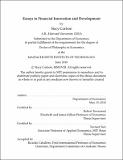| dc.contributor.advisor | Robert Townsend and Tavneet Suri. | en_US |
| dc.contributor.author | Carlson, Stacy(Stacy Lynn) | en_US |
| dc.contributor.other | Massachusetts Institute of Technology. Department of Economics. | en_US |
| dc.date.accessioned | 2019-09-11T21:54:11Z | |
| dc.date.available | 2019-09-11T21:54:11Z | |
| dc.date.copyright | 2018 | en_US |
| dc.date.issued | 2018 | en_US |
| dc.identifier.uri | https://hdl.handle.net/1721.1/122051 | |
| dc.description | This electronic version was submitted by the student author. The certified thesis is available in the Institute Archives and Special Collections. | en_US |
| dc.description | Thesis: Ph. D., Massachusetts Institute of Technology, Department of Economics, 2018 | en_US |
| dc.description | Cataloged from student-submitted PDF version of thesis. "Some pages in the original document contain text that runs off the edge of the page"--Disclaimer Notice page. | en_US |
| dc.description | Includes bibliographical references. | en_US |
| dc.description.abstract | In this thesis, I use rich individual- and household-level data to explore the impact of different forms of financial innovation on development outcomes in Africa. Chapters 1 and 2 utilize data from a digital lender that provides credit over mobile phones. Chapter 1 presents novel evidence on the magnitude of consumer liquidity constraints and the relative importance of the various forms of asymmetric information that may contribute to them. I find that borrowers almost always take out the maximum credit line available to them, consistent with short-term liquidity constraints. I then use quasi-experimental variation in credit policies across individuals and time to estimate the relative magnitude of selection and incentive effects among new borrowers. I find that information asymmetries go a long way toward explaining high observed default rates. Chapter 2, my job market paper, explores the impact of dynamic incentive schemes on borrower behavior in the digital credit market. I use a series of quasi-experiments induced by policy nonlinearities to estimate the effect of progressive lending policies on borrower repayment decisions. I find that new borrowers who receive a larger initial loan are more likely to default on that loan. By contrast, repeat borrowers who receive a larger loan (relative to their previous loan) are actually less likely to default. I provide evidence that this reflects a strategic repayment motive, whereby borrowers repay in order to get access to larger loans in the future. Chapter 3, written with Yu Shi, uses household-level data from a panel survey in Nigeria to explore the relative importance of formal versus informal finance. We find that informal financial markets remain important and are quite effective in enabling consumption smoothing by lower-income households and businesses in Nigeria. | en_US |
| dc.description.statementofresponsibility | by Stacy Carlson. | en_US |
| dc.format.extent | 228 pages | en_US |
| dc.language.iso | eng | en_US |
| dc.publisher | Massachusetts Institute of Technology | en_US |
| dc.rights | MIT theses are protected by copyright. They may be viewed, downloaded, or printed from this source but further reproduction or distribution in any format is prohibited without written permission. | en_US |
| dc.rights.uri | http://dspace.mit.edu/handle/1721.1/7582 | en_US |
| dc.subject | Economics. | en_US |
| dc.title | Essays in financial innovation and development | en_US |
| dc.type | Thesis | en_US |
| dc.description.degree | Ph. D. | en_US |
| dc.contributor.department | Massachusetts Institute of Technology. Department of Economics | en_US |
| dc.identifier.oclc | 1108620052 | en_US |
| dc.description.collection | Ph.D. Massachusetts Institute of Technology, Department of Economics | en_US |
| dspace.imported | 2019-09-11T21:54:09Z | en_US |
| mit.thesis.degree | Doctoral | en_US |
| mit.thesis.department | Econ | en_US |
